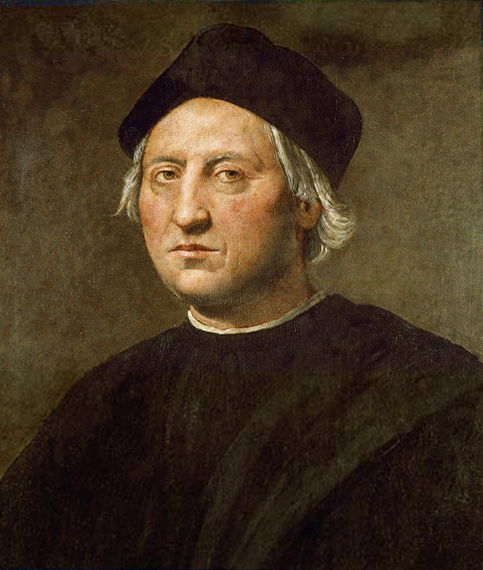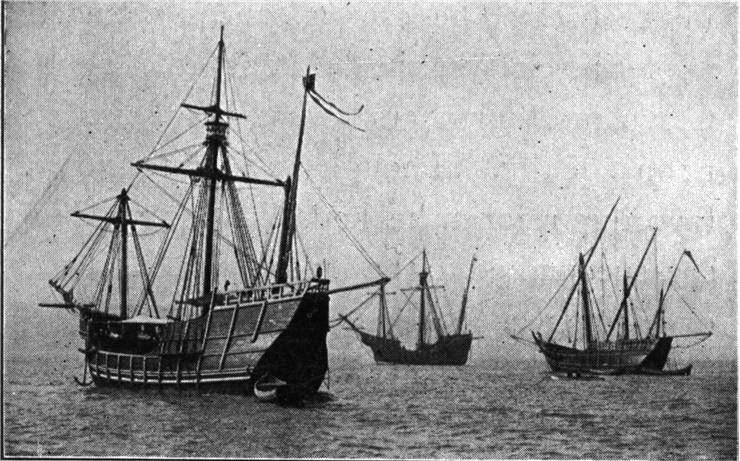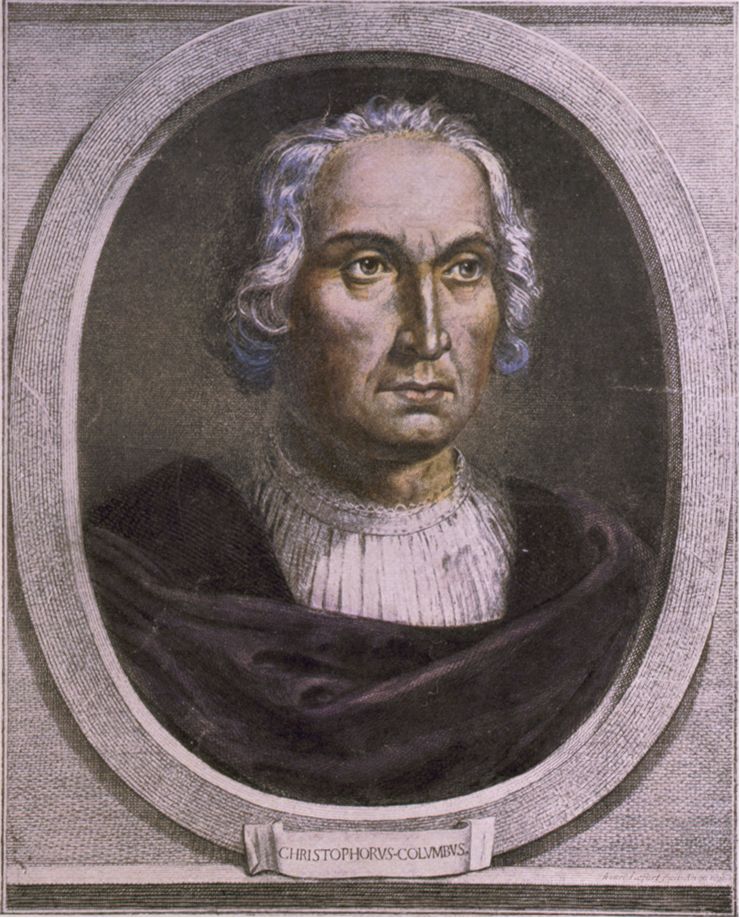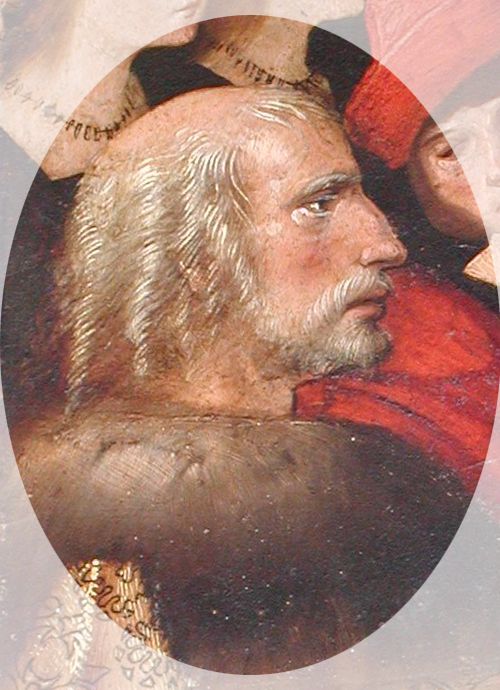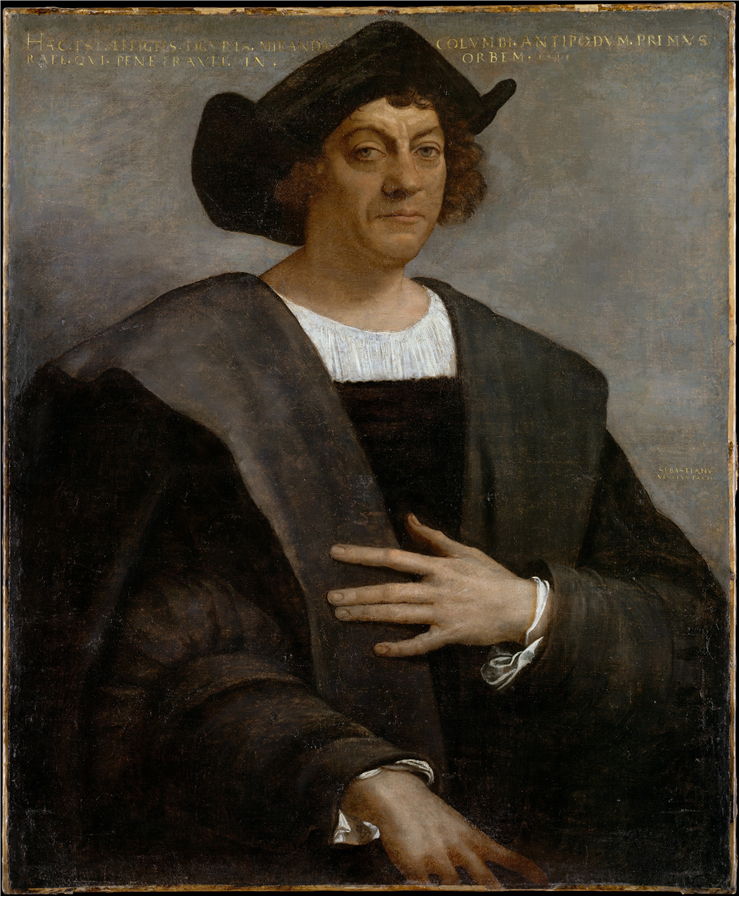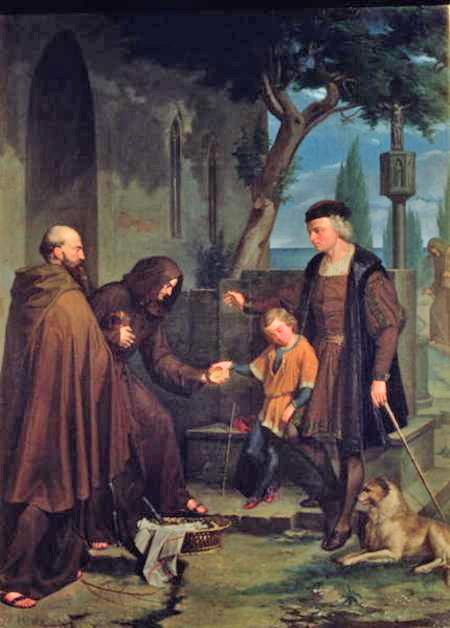Christopher Columbus Explorer
Christopher Columbus (1451 - 1506) was a celebrated Italian explorer and navigator who discovered continents of the Americas and held a key role in its initial colonization. Taking advantage of the newly developed naval technologies for extended sailing outside the view from the shore, and under the auspices of the Catholic Monarchs of Spain, who represented one of the many European kingdoms who desperately wanted to discover a sea route to the distant and rich lands of India and China, he managed to complete four voyages across the Atlantic Ocean between 1492 and 1503, believing that he has, in fact, found the eastern shores of Asia. In fact, when he landed on the shores of San Salvador during his first journey to the New World, a small island in the Bahamas archipelago, he believed he has landed in Japan. Throughout the next three journeys across the Atlantic, claimed several more lands to the Crown of Castille, including islands in Greater and the Lesser Antilles and Caribbean coast of Venezuela.
Even though the newly-discovered continents were not part of Asia (they would eventually be named after Amerigo Vespucci, a Florentine naval explorer who proved to the world that the coast of Brazil and the rest of the "West Indies" did not have core elements of the real Asian coasts), Christopher Columbus was awarded for his discovery, becoming the governor of the first permanent colony in the Americas on the island of Hispaniola (modern-day Haiti).
Christopher Columbus is remembered today as one of the greatest explorers of all time.
It is important to note that Christopher Columbus and his exploratory fleets were not the first Europeans who have landed on the shores of the American continents. Historical records have confirmed that the Norse explorers managed to establish short-lived colonies in North America. Still, because those discoveries did not lead to the full-scale colonization of new lands, modern history credits Christopher Columbus as the man who discovered and established travel routes across the Atlantic.
The discovery of the Americas shifted the balance of power, economy, and warfare in Europe, leading to the several-century-long period of aggressive exploration, conquest, and colonization. Because his discovery has led to the development of what is today called modern Western word, Christopher Columbus has remained remembered as one of the most important and influential explorers of all time, rivaled perhaps only by the Portuguese explorer Ferdinand Magellan (1480–1521) who was the first who successfully sailed around the world just three decades after the discovery of the Americas.
Early Life
Born as Cristoforo Colombo in the territory of the Republic of Genoa (modern-day northwest Italy) before 31 October 1451. The exact date of his birth is unknown, but the exact location of his birth is still a thing of a dispute between various historians. While he was known in Italy under that name, he became better known around Europe with the Anglicisation of the Latin version of his name Christophorus Columbus. His name was also frequently used in historical records in languages such as Ligurian (Cristòffa Cónbo) and Spanish (Cristóbal Colón).
Christopher Columbus was a son of middle-class wool weaver and shop owner Domenico Colombo who worked and lived in the cities of Genoa and Savona. His mother was Susanna Fontanarossa (born in Corsica), who had five children – Cristoforo, Bartolomeo, Giovanni, Giacomo, and a daughter named Bianchinetta.
Even though he was born in Italy, Christopher Columbus became a seasoned navigator only after he settled in Portugal.
Historians agree that Christopher Columbus never did learn to write in his native Genoese variety of Ligurian, and in 1470 it was confirmed that he and his family moved to Savona, where his father Domenico bought a local tavern. In the later writings made by Christopher Columbus, he said that he first went to the sea at 10. Still, the first confirmed record of him being a part of the crew is dated 1470 when he was hired to serve on the Genoese warship of René of Anjou, who sighted conquering the Kingdom of Naples.
During the 1470s, records speak of several naval jobs Christopher Columbus undertook, mostly with Genoa ships, which traveled across the Mediterranean. This includes a trip to the Aegean islands (now a part of Greece, but then in part controlled by the Republic of Genoa), armed protection of the treasure fleets that traveled all the way to England and Ireland, and more. By 1477, 26-year-old Christopher Columbus already had a lot of naval experience, has established connections with many trading families across Europe, and has decided to settle down in Lisbon where he married Filipa Moniz Perestrelo, daughter of the Portuguese nobleman and Porto Santo governor Bartolomeu Perestrello (who also claimed to have discovered this island off the coast of Africa in North Atlantic archipelago of Madeira).
In the early 1480s, Christopher Columbus traded extensively between Portugal and the western coast of Africa, managing to visit all major Portuguese ports up to distant Elmina at the Guinea Coast. As a Portuguese trader, Columbus learned to speak, read, and write many languages, including Latin, Castilian, and Portuguese. This enabled him to better educate himself about naval tactics, navigation, geography, history, and astronomy. While he was not a scholarly man, he was curious about the world, reportedly made countless notations on the works he managed to get a hold of, and often formed ideas about the nature of the world. He was also a devout Christian and often found inspiration in the Bible for providing reasons for his exploits in exploration and discovery.
Records show that he briefly returned home to Portugal in 1485 to handle his dead wife's estate and take his son Diego with him. Shortly after that, he established a relationship with a mistress Beatriz Enríquez de Arana, who would give him another son Ferdinand in 1488.
Historians consider the entire period of his life up to 1492 to consider the entire period of his life up to 1492 as the prelude to his main exploit – the start of the journey across the Atlantic. But to organize such a feat, Christopher Columbus had spent several years of his life lobbying Portugal and Spanish monarchs, eventually getting permission, assurances, and funds to form his exploratory fleet.
Christopher Columbus Origin Theories
As more than five centuries separate us from Christopher Columbus's time, many modern researchers have started several lines of questioning that tried to discover his true origin and nationality. The main point of contention lies in the fact that young Christopher, who is officially believed to be born and raised in northern Italy, most likely never learned to read or write his native langue, or more specifically, a Genoese variety of Ligurian. Instead, all his writings (except a few Latin and a few sentences in Italian) were done in the Spanish language that he learned later in life.
Officially, many of the historical records pointing to the origin of Christopher Columbus's birth were gathered from documents of his immediate family and records of his contemporaries. However, those records of his Genoese origins are officially recognized, and they even include writings of his son Ferdinand, Genoese and Venetian ambassadors in Spain, other European government officials, contemporary writers and historians, and over 60 Italian testimonies from the 16th century who all clearly describe Christopher Columbus as Genoese.
Modern historians only accept the Genoese origin of Columbus, but that did not stop many contemporary critics from trying to provide insights into alternate origins.
However, several modern deliberations have put those records in question, although many of such new claims were found unsubstantiated and without any concrete proof of alternative origin.
Here are some of the modern theories of his origin that appeared in public since the early 19th century:
Catalan hypothesis – Some 20th-century researchers have proposed a theory that Christopher Columbus was, in fact, born and raised in Catalan-speaking areas of Spain, where he learned to read and write the Spanish language. One of the biggest "proofs" they point is that Christopher Columbus himself, his family, and contemporaries always referred to him by his Spanish name of Christobal Colom. There are also mild claims that his handwriting style is very much like those who grew up in Catalan areas.
Catalan-Jewish hypothesis – Some linguists have found a possible connection between Christopher Columbus's writings to hide Catalan origin and hidden Jewish origin. This claim was presented because Columbus ** on rare occasions, wrote some Hebrew words** and has referenced few Jewish High Holidays in the records of his first voyage across the Atlantic. Other modern historians tried to connect him to Judaism via the origins of his family name, or that he was "converso," Spanish Jew who has publicly converted to Christianity.
Portuguese hypothesis – In the early 19th century, a claim was released to the public that Christopher Columbus was Portuguese. Later expansions of this claim included even unsubstantiated allegations that he was a spy with a concealed name, who used the public name of Christopher Columbus to destabilize the power of the Spanish court intentionally. Modern historians never found any proof of this.
Polish hypothesis – During the mid-20th century, a writer of The Polish Review commented that there are rumors of possible polish origins of Christopher Columbo. According to those rumors, he was, in fact, an offspring of the Polish King Wladyslaw III Jagiellon, who survived his official death in 1444 and settled in Madeira under the name of Henrique Alemão. Unfortunately, this hypothesis has no basis in any found historical record.
Sardinia hypothesis – Modern Spanish historian Marisa Azuara has hypotheses that Christopher Columbus could, in fact, be a Sardinian noble. During the time of his birth, Sardinia was under the economic and political rule of Genoa.
Corsica hypothesis – Locals of the Corsica town of Calvi claim that one of the historic houses on their land is, in fact, the birthplace of Christopher Columbus.
Norway hypothesis – Norway writers Svein Grodys and Tor Borch Sannes have also tried to claim Christopher Columbus's origins. They found a connection in the family name that resembles words of the Nordic language and some similarities between the family coat of arms of the family Columbus and the royal Bonde lineage of Sweden. They even speculated about the specific origin of Christopher Columbus, connecting him directly to the family of the Charles VIII of Sweden/Charles I of Norway.
Scotland hypothesis – In 2009, one Spanish amateur historian released the claim that Christopher Columbus was baptized under Pedro's name and that his family name was Scotto.
Christopher Columbus' Quest for Asia
Before the rise of the European Renaissance, this continent was essentially cut off from the trade with Asia by various border conflicts, hostile kingdoms, harsh terrain, unsafe and unreliable road networks, and the mere fact any journey had to successfully endure for several months before reaching to rich Asian countries of India and China where exotic goods such as spices, silk, carpets, weapons, precious stones and more could be acquired. However, the expansion of the Mongol Empire during the 13th century managed to completely change the basic requirements for trade across Asia, enabling merchants to take advantage of the fabled Silk Road, which started at Constantinople, went above Arabia and Persia, and finally reached lucrative Asian markets.
While sea travel to Asia was possible via Maritime Silk Road that involved the land transfer of cargo between the Red Sea and River Nile, the travel on that route was long and expensive. As the Mongol Empire fell, so did their control overland Silk Road, which disrupted their unified taxes and general road security. With an increasing percentage of trade convoys being disrupted by road thieves and numerous high taxes, European countries with large naval fleets started a serious investigation into finding new trade routes to India and China.
The primary reason for Columbus's journey across the Atlantic was not to prove that Earth is round but to find a safe naval route to Asia.
By 1470, the first talk about "sailing west" to reach India started to gain traction with astronomers of Spanish and Portuguese courts. This notion was instantly rejected, and instead, several exploratory ships were sent to chart the coast of Western Africa, which eventually led to the famous discovery of the Cape of Good Hope (the southernmost tip of the African continent) Bartolomeu Dias in 1488. While many laid their hopes into a circumnavigation of Africa, Christopher Columbus and his brothers became more and more attracted to the idea of sailing west, basing his belief on the ancient teachings of Aristotle and Ptolemy that were the basis of European medieval astronomy.
Using somewhat flawed measurements that depicted the circumference of the Earth as 30,200km (when it was in fact around 40,000 km), and the skewed belief about the size of the Asian continent, Columbus came to the estimated distance that he should travel west before reaching the Japan – 3,700 km. In reality, such a trip is much longer, and it is closer to 20,000 km. Nevertheless, equipped with the 15th-century naval technology and ships and the knowledge about the consistent winds across the Atlantic, he formulated a plan to enable the small fleet to travel such a short distance across the uncharted Atlantic Ocean and reach the shores of Asia.
Four European countries refused to back Columbus' voyage - Genoa, Portugal, England, and France.
However, securing the funding was a task that Columbus would spend several years of his life. He unsuccessful proposed his plans to Portugal court, who flatly rejected his claims (and the requirement to be named "Great Admiral of the Ocean" and governor of all the newly-discovered lands). His search for funding was also compromised by the arrival of the news of Bartolomeu Dias's successes on the western coast of Africa.
After several failures in Portugal at the court of King John II, Columbus sought support from governments and naval fleets of Genoa and Venice. He even sent his brother to the English court to petition Henry VII of England for exploratory funds. Unfortunately, all his petitions were unsuccessful. Finally, on 1 May 1486, Columbus received a preliminary seal of support from the Ferdinand II of Aragon and Isabella I of Castile, Spanish rulers who have just finished uniting the Spanish lands and were greatly interested in expanding the influence and reach of their naval fleets. A few years later, during which Columbus had to convince not only the Spanish Royal court but also their astronomers and Catholic church officials (even using Bible references as the proof for his nautical claims), the final deal for the formation of the exploratory fleet was after some commotion signed in January 1492 (Columbus actually decided to leave the city of Córdoba just before the deal was actually accepted, prompting Portugal King to return him to the court quickly).
By the terms of the deal, Christopher Columbus was granted ** the Admiral of the Ocean Sea** and appointed into the role of the governor of all lands that he should discover and claim for Spain. This included the right to 10% of all revenues from new lands in perpetuity for him and his heirs.
Voyages of Christopher Columbus
After securing funding from the Crown of Castile, Columbus successfully traveled to the "West Indies" in 1492, which enabled him to travel to the Americas three more times before the end of 1503. His discovery marked the end of the Medieval isolation of the European continent, the beginning of the age of European exploration, colonization of the American continents, and is regarded today as when modern Western history was born.
During his entire life, Columbus remained insistent that the lands he discovered were the easternmost reaches of the Asian continent.
First Voyage of Christopher Columbus
On the evening of August 3rd, 1492, Christopher Columbus set his sales and exited harbor of Palos de la Frontera with three ships – his carrack flagship with three masts Santa María and two smaller caravels, Santa Clara and the one whose name is lost to history, but it eventually earned nickname Pinta ("painted one"). After restocking supplies on the Canary Islands, Columbus' fleet set their sails to the west across the unexplored Atlantic Ocean. After five weeks on the sea, the members of the exploratory fleet sighted what will be later going to be named San Salvador Island (modern-day Bahamas).
First The first sighting of the New World happened in the early hours of 12 October 1492 by the lookout on the ship Pinta. Christopher Columbus later claimed this discovery for himself.
He encountered native people of Bahamas (nations of Lucayan, Taíno, and Arawak), took note of their simple cultural and technological developments, and continued sailing to the northeast coast of Cuba and northern coast of Hispaniola where his largest ship Santa Maria was lost due to shallow waters. There on Hispaniola, he left 39 men, forming the first modern settlement of Europeans in the Americas. After the long journey eastward and after being separated from his other remaining ship by the storm, Christopher Columbus returned to Lisbon on 4 March 1493.
Second Voyage of Christopher Columbus
The second voyage of Christopher Columbus to the New World was much larger than the first. He had under his command a total of 17 ships, 1,200 men (including farmers, soldiers, priests, and workers from other professions), and supplies needed to establish a full colony across the Atlantic. After launching on 24 September 1493, they quickly stopped on the Canary Islands and headed westward until they reached the island Dominica of the chain of Windward Islands on November 3rd. Fleet traveled northwest, charting several other smaller islands, sighted distant Virgin Island chain until he reached Puerto Rico. After a skirmish with the violent natives, he returned to Hispaniola, where he discovered that another group of natives had destroyed his settlement from the original journey. 100km eastward, he established a new settlement called La Isabela, which was fairly short-lived due to its poor location.
With the settlement formed, Christopher Columbus returned to Portugal.
Third Voyage of Christopher Columbus
The third journey of Columbus was aimed to resolve a task that was given to him directly by King John II of Portugal, who, over the several years, received reports from Western African shores that canoes from "distant western land" came across the Atlantic.
In 1498, Columbus set his sails for the exploration of the Trinidad and the northern coast of South America.
Columbus aimed to travel southwest from Cape Verde islands, find new lands and potentially discover a passage to continental Asia. Equipped with six ships (three for his task and three carrying supplies to Hispaniola), he launched from Sanlúcar, Spain, on 30 May 1498 on a much more southerly path. After a long and difficult journey, he finally sighted the island of Trinidad on 31 July. He landed on Trinidad, charted shores of Venezuela, the delta of Orinoco river, and landed on South America at Paria Peninsula.
During his trip to Hispaniola, he charted several smaller islands and sighted Tobago and Grenada. He remained on Hispaniola for more than a year, battling dissatisfied settlers who openly defied his rule as a Governor. After prolonged political (and physical) clashes, he was eventually arrested for mismanagement and transported to Spain in chains. He was later freed but was barred from resuming his post as the Governor on Hispaniola.
Fourth Voyage of Christopher Columbus
Still believing all the discovered lands are part of eastern Asia, the final voyage of Christopher Columbus to the New World was aimed to find the Strait of Malacca that connects the western Pacific Ocean with the Indian Ocean.
With the fleet of four ships, he sailed from Cádiz on 11 May 1502 and landed on the Caribbean island of Martinica (modern Martinique) on 15 June. Anticipating the imminent arrival of the hurricane, he quickly sailed to Santo Domingo on 29 June, where he was stopped from landing by new governor Francisco de Bobadilla who took his position three years ago. Ignoring the warning from Columbus, Bobadilla picked just that time to sail away with a 30-ship strong treasure fleet toward Spain, right into the strong winds of the hurricane. Christopher Columbus's ships were almost undamaged, while 29 out of 30 ships of Bobadilla (including the immense gold) went under the waves.
The fourth voyage of Columbus to the New World was a costly one. The numerous setbacks not only prolonged his journey, but his health also suffered.
One month later, on 30 July, Columbus arrived near the coast of Honduras, where he found sea merchants of South America that his King has heard from African reports. During the next two months, he explored southward, charting the coasts of Honduras, Nicaragua, Costa Rica, and Panama, where he elected to stay over winter. During their stay in Panama, Christopher Columbus collected information about local gold deposits and the westerly river strait that leads to another ocean. Finally, on April 16, with one ship destroyed and part of his crew left behind to garrison a compound at the mouth of Belén River, he started his journey back to Hispaniola. However, damaged ships forced him to land in Jamaica, where they remained stranded for a year, partly due to the influence of the new Hispaniola governor who prevented rescue efforts. Christopher Columbus and his crew were eventually rescued on 29 June 1504 and managed to reach the harbor of Sanlúcar, Spain, on 7 November of the same year.
Was Christopher Columbus, a tyrant?
During his life, Christopher Columbus was accused several times of being too harsh toward his subjects, too rigid in his rule over New Indies, and in some cases, even openly accused to be of being a tyrant, unable to manage land and people, and more. Many historians agree that blame for this can be placed on his upbringing, level of education, and lack of experience in governing large groups of people. However, there is also one mitigating circumstance that was well recorded in history. After several of his journeys across the Pacific, a long time spent on the sea, and a lack of proper medical care, the health of Christopher Columbus suffered greatly.
On his third voyage to New Indies, the first permanent colony on Hispaniola was finally established. Unfortunately, by the time he arrived there, he suffered from physical and mental exhaustion. He was weakened by aggressive arthritis, and his sight was damaged by ophthalmia. During that time, he even requested the Spanish crown to appoint a special royal commissioner that would help him govern the settlement of Santo Domingo. However, the dissatisfaction of his subjects there could not be stopped, and the word of his incompetence, tyranny, and weakened health managed to pass over the Atlantic and reach the Spanish court. This led to the 1499 removal of Christopher Columbus from the position of the "Viceroy and Governor of the Indies" that he managed to negotiate for himself before the first famous journey to the New World. The new governor's arrival to Hispaniola, Francisco de Bobadilla, shed new light on why all these complaints were originally sent across the Atlantic.
Recent discoveries about the life of Christopher Columbus have rocked the reputation of this famous explorer.
Francisco de Bobadilla commissioned a detailed 48-page report for the Spanish crown that detailed how Columbus, his brothers, and close allies treated his subjects, both those from Europe and the native people of Central America during the seven years Columbus held the power of the Governor of the Indies. The report included testimonies of 23 people, and detailed the events of torture, mutilation, slavery, public humiliation, ordering of brutal attacks on native people, the massive killing of natives (both combatants and innocents), brutal methods of dissuading further dissent in the native American ranks, and more.
Seeing this document, the Spanish Crown immediately arrested Christopher Columbus and his brothers upon their arrival in Spain. However, after six weeks, they were all freed. All of their wealth was also restored, but Christopher Columbus was permanently removed from the role of the Governor.
Other historical documents, including Columbus's personal diary, have provided historians with greater insights into how he operated and treated people around him. During that part of European history, commanders of all naval vessels were used to total power over their subjects, and they often employed harsh methods to keep their crews in line. While some of the naval commanders from that time did receive proper education and followed at least some forms of official conduct (most often military ship captains and officers with long experience of command), many were poorly educated and lacked communication skills, did not have the knowledge or know-how to govern over large communities, and had respect or empathy toward less less-developed nations outside of "civilized Europe." In addition, many ship captains (and ship crew members) from that time were openly supporting slavery, and they sanctioned (and often used their power) for the public showcases of revenge, excessive punishment, and more.
In the case of Christopher Columbus himself, he was openly hostile to native Americans he discovered in his journeys across the New World and during his time as the Governor, he planned how to mislead best, or force natives to be servants, twisted their economy to be based on exchanging gold for cheap goods or services, ordered excessive attacks against natives who attacked his holdings or subjects, and even reportedly refused to allow them to learn about Christian faith because that would prevent him from having access to free slave labor. In his own words, he also supported sexual slavery. In one testimony in Francisco de Bobadilla's report on Christopher Columbus' conduct as a governor, he congratulated his brother for ordering public shaming of a woman who had stated that he was of "lowly birth." First, the woman was paraded naked through the settlement in Hispaniola, and then her tongue was cut out.
Publicly, Columbus always supported the Christian church and claimed the conversion of non-believers as one reason for his exploratory journeys.
Later life and death
After the incredibly strenuous fourth journey to the New World, the health of Christopher Columbus was in such a poor state that he never returned to sea again. He was also out of political favors, which were strained not only because of his previous incarceration and release from prison but also great difficulties returning home after his shipwreck in the Caribbean when local governors and officials refused to help.
In the years after his return to Spain, he continued feeling the negative health effects of the medical conditions that he encountered in the New World, most notably a strong fever that struck him on his return home from the 4th and final journey. Repeated instances of strong fever returned to him from time to time, including long periods when he was forced to remain in bed and suffer prolonged gout attacks, weakened immunity, and even bleeding from the eyes. Many historians agree that these fever attacks were, in fact, Reiter's syndrome, a strong joint inflammation disease.
The fifth and final journey of Christopher Columbus across the Atlantic happened after his death.
Christopher Columbus died on 20 May 1506, at the estimated age of 56. He succumbed to the fever in his bed in Valladolid, Spain. His remains were eventually transferred across the Atlantic to Colonial Santo Domingo (present-day Dominican Republic) in 1542, moved to Havana, Cuba in 1795, and finally returned to Spain in 1898, where he remains to this day, in the elaborate catafalque in the Cathedral of Seville.
In the years before his death, Christopher Columbus wrote two books - Book of Privileges (1502), where he detailed the rewards that the Spanish Crown promised him and his heirs, and Book of Prophecies (1505), where he described his exploratory achievements as the fulfillment of Bible prophecies.
Christopher Columbus Legacy
To this day, Christopher Columbus is remembered as one of the greatest explorers of all time. His exploits led to the discovery of the Americas and kickstarted a centuries-long era of European exploration, expansion, conquest, and colonization. For all intense and purposes, his discovery of the New World essentially shaped the modern Western World. For that and his many other secondary achievements (such as popularization of the fact that Earth is round ), he is remembered in a positive light worldwide.
However, in recent times, his conduct and beliefs were strongly criticized by modern historians. The recent discovery of Francisco de Bobadilla's detailed 48-page report on Christopher Columbus's conduct during his years as Governor on Hispaniola have panted a much grimmer light over his reputation. His aggressive actions in colonization and poor treatment of natives have greatly influenced his memory. Some historians believe that it was, in fact, his crewmembers who were responsible for spreading diseases such as Syphilis and "Great pox" plague across Europe when they returned home and joined armies of King Charles VIII who marched from Spain to Italy and back.
Over the past several centuries, and especially in the 20th century, Christopher Columbus was a theme of many art pieces, multimedia, and other works. This includes literature, films, multimedia, sculptures, games, operas, and other art forms.
| Name | Christopher Columbus |
| Known As (Other Names) | Cristoforo Colombo, Cristòfor Colom, Cristóbal Colón, Cristóvão Colombo, Christophorus Columbus, Christoffa Corombo, Christophe Colomb, Kolumbusz Kristóf |
| Born | Before 31 October 1451 |
| Place of Birth | Genoa, Republic of Genoa |
| Died | 20 May 1506 |
| Place of Death | Valladolid, Crown of Castile |
| Category (Occupation/Profession) | Maritime explorer |
| Nationality | Italian |
| Religion | Roman Catholicism |
| Known For | Reached the New World |
| Famous Expedition(s) | Four voyages across the Atlantic Ocean |
| Spouse(s) | Filipa Moniz Perestrelo, Beatriz Enríquez de Arana |
| Children | Diego Columbus, Ferdinand Columbus |
| Parent(s) | Domenico Colombo, Susanna Fontanarossa |
| Relative(s) | Giovanni Pellegrino, Giacomo Bartholomew, Bianchinetta Columbus |
| Rank (Title) | Admiral of the Ocean Sea; Viceroy and Governor of the Indies |
| Monuments | Seville Cathedral |
